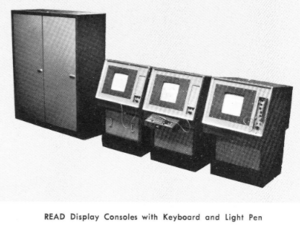Difference between revisions of "Stanford Time-Sharing System"
From Computer History Wiki
m (+Cat) |
(Picture of Philco displays.) |
||
| Line 1: | Line 1: | ||
| + | [[Image:Philco_READ_displays.png|thumb|right|Philco displays.]] | ||
| + | |||
'''Stanford Time-Sharing System''' was the formal name for a series of experimental [[time-sharing]] systems at Stanford, called Thor, Odin, and Zeus. They ran on a [[PDP-1]] in Pine Hall, which was shared between Patrick Suppes at [[IMSSS]] and John McCarthy's newly started [[Stanford Artificial Intelligence Laboratory|AI project]]. | '''Stanford Time-Sharing System''' was the formal name for a series of experimental [[time-sharing]] systems at Stanford, called Thor, Odin, and Zeus. They ran on a [[PDP-1]] in Pine Hall, which was shared between Patrick Suppes at [[IMSSS]] and John McCarthy's newly started [[Stanford Artificial Intelligence Laboratory|AI project]]. | ||
Revision as of 05:34, 12 June 2023
Stanford Time-Sharing System was the formal name for a series of experimental time-sharing systems at Stanford, called Thor, Odin, and Zeus. They ran on a PDP-1 in Pine Hall, which was shared between Patrick Suppes at IMSSS and John McCarthy's newly started AI project.
The system had twelve Philco vector displays.
There was a very early full-sceen text editor called TVEDIT, written by Brian Tolliver.
Both the hardware and software influenced the time-sharing system on the SAIL PDP-6.
